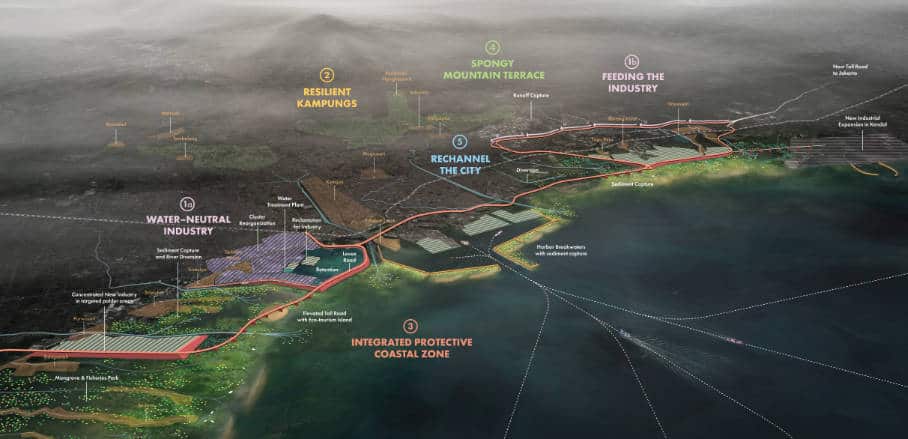Building with Nature in Urban Contexts – Chances and Challenges of Nature-based Solutions
With more than half of the global population living in urban areas, cities need new solutions to tackle climate-related challenges. Erik van Eekelen, Matthijs Bouw, Reinder Brolsma and Harro Wieringa on the approach of Building with Nature.
Most often cities are located at the crossroads of transport modes, at the coast, along rivers or in the deltas of our planet. Since industrialisation, the urban-water interface has been increasingly mediated by monofunctional grey infrastructure such as flood control barriers, piped stormwater infrastructure as well as straightened and hardened shorelines. While these efforts yielded certain short-term economic benefits, circumscribing space for nature and living systems has been detrimental in the long term.
The impact of climate change adds urgency to redesign the urban-water landscape. Increasing average temperatures, changes in precipitation, more frequent extreme weather events, and sea level rise exacerbate existing challenges. Next to the direct effects on its citizens, heavy-impact events – such as the Pakistan floods last June but also more common and day-to-day issues like local flooding, pollution, heat stress and drought – trigger further biodiversity loss, ever-accelerating the issue.
The Need to Increase Climate-Resilience
The Building with Nature (BwN) approach is creating, implementing and upscaling Nature-based Solutions (NbS) for water-related infrastructure. Including resilience and robustness applying NbS can provide additional flood storage, temper extreme heat and recruit plants and animals. The benefits of NbS are not limited to an increased climate-readiness, which brings associated land-value increase, it does also enhance the natural environment and liveability of the city, which in turn provides the well-being of its citizens and supports public health.
Challenges in applying the BwN approach are posed by the limited availability of space to build and use large-scale ecosystems and their landscapes. The multitude of stakeholders present in the urban context enhances the need to deliver multifunctionality. Still, BwN work in Dutch cities, such as Dordrecht, Rotterdam, and Nijmegen, has shown that taking the larger scale landscape perspective as the starting point delivers the best results.
Building with Nature Shows Improved Climate Adaption
In Rotterdam, for example, using the river as a tidal park serves the need for recreational amenities, whilst at the same time providing space to limit flood implications. By restoring connections, such as the Plan Tij in Dordrecht, disconnected ecological systems can be reconnected and integrated with climate-adaptive residential development. Finally, the Spiegelwaal in Nijmegen has demonstrated that even larger-scale interventions for flood safety provide vital opportunities to connect the city with nature and deliver associated benefits. Driven by an urge to undertake climate-proof actions, the BwN approach delivers NbS that do provide added value for both the cities’ ecosystems and their inhabitants.
The city of Semarang on the northern coast of Central Java in Indonesia constitutes another example of BwN in an urban setting. Semarang is currently experiencing a series of water-related threats, including flash floods, land subsidence and water scarcity. Within the framework of the Water as Leverage programme, a large coalition of local and international experts came together to develop an explorative urban model for Semarang, capable of delaying runoff and vastly increasing water retention and reuse. Two complementary strategies were formulated for the city by the teams: Cascading Semarang and ONE Semarang.
New Explorative Urban Models for Semarang in Indonesia
The Cascading Semarang urban strategy, designed in collaboration with local authorities, builds on five concepts, which differ in scale and strategic approach according to zoning, topography, and projected results. The concepts are complementary. Combined they provide a comprehensive solution for the whole Semarang Metropolitan Region. Water strategies vary according to different zoning: extended river, spongy forest, spongy urbanisation, and water-efficient agriculture. Each approach aims to use new water infrastructure to generate sustainable development, improving not only water management but also the economy, public space, waste processing and clean energy production.
The ONE Semarang strategy focused on the lower-lying geographies like the industrial areas near the port and the coast. In part extending the successful BwN coastal restoration project in Demak (just east of the city), the strategy mixed a set of grey and nature-based measures that will reduce subsidence, redirect sediment to help strengthen the mangrove belt and build up foreshores, and change the hydrology of the coastal zone to reduce urban flooding of the port areas and improve biodiversity.
Introducing Nature-based Solutions: Challenges and Lessons Learned
Key insights in developing both strategies reiterate that introducing NbS in urban areas is challenging. Often, the context is already so ‘unnatural’ and developed that NbS per se will not work and finding the right combination of conventional and nature-based measures is critical for offering both the necessary protection from extreme weather events and the benefits.
However, there are certain enablers that are considered keys to successfully implementing NbS. Firstly, the involvement of multiple stakeholders is critical as NbS requires an integrated approach in which all perspectives are taken into account. Also looking further into the project’s lifespan is required, as capital investment and maintenance are co-designed, requiring that outcomes are monitored, and projects adapted when necessary. This in turn requires institutional embedding and developing of the right business case. Finally, capacity building and advocacy for the multiple benefit strategies helped convince the other stakeholders and build the necessary stewardship for NbS.
The Water as Leverage programme for Semarang has further raised awareness of urban situations with higher complexity of physical and social systems than in rural areas, proving that the work on all of these enablers is ever-more critical.
